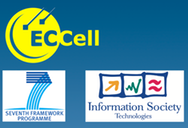Synthesis of hybrid microelectronic-microfluidic control systems for aqueous solutions of these molecules, capable of controlling their microphases and chemical reactions. Reactors based on hybrid FPGA-microfluidic chips using silicon-PDMS hybrids have already been developed and digital voltage control of the local concentrations of both charged molecules (e.g. DNA) and supramolecular assemblies such as vesicles has been demonstrated. Specific local surface patterning using alternating polyelectrolyte deposition, under electric field control in these structures will be performed and the microreaction-environment optimized for the tasks 3-6 below. Simulation of the electric field biased self-assembly and reactions with extended DPD code will allow digital field arrangements, surface coatings and microreactor geometries to be optimized.
Integrate the SCP-DNA chemistry in the electronic microfluidic hybrid system to create electronic chemical cells, which can sustain themselves and self-reproduce from one self-contained location to another. Initially attention will be devoted to the sol-gel transition between micelles and gel-like structures of SCP-DNAs, subsequently attention will also be devoted to the micelle-vesicle transition known to occur for certain SCP-DNAs. The reproduction cycle of the artificial cell consists of alternating mobile micellar and stationary gel phases, supported by electric field control of micellar concentration. Replication of SCP-DNAs takes place in the gel phase under redox reaction control.
Cell division is controlled by multiple electric field traps for mobile micelles during the transport phase. Since micelle based gels of triblock copolymers can also selectively constrain DNA mobility, modulating the transport of specific DNA molecules and allowing reactions with metabolites to take place, we can use them as an alternative to vesicles for cell containment. Additionally, electric field control of polyelectrolyte surface deposition will allow electronic control of chemical processing via the local surface environment. While micellar gel structures will be the main focus of attention, starting with DBCs or catalipids forming micelle structures, DNA-templated reactions can also result in modifications yielding vesicles, which may be split and regrown to reproduce under electric field control.
a) Establish electric field controlled self-replication of SCP-DNAs in the absence of enzymes, via local concentration monitoring by changing the control voltages of the corresponding microelectrodes. Non-enzymatic replication of DNA (parabolic kinetics) is strongly sensitive to concentration effects, which have proven to be controllable via electric fields. Reversible cyclic modulation of pH by local electrolysis in flowing systems will also be employed to couple chemical replication with electronic signals.
b)Establish electric field controlled microphase self-assembly and selective containment of SCPDNA molecules. Electric field control of self-assembly is either directly via concentration control of self-assembling constituents or induced pH leading to phase changes or indirectly via electric field controlled surface modifications (polyelectrolyte deposition) or mobility modulation (e.g. gel phase shifting). The research will evaluate and optimize these techniques using reconfigurable electronic microfluidic chips (FPGA outputs) and custom software in conjunction with physical simulation.
c) Establish redox synthetic coupling of redox active SCP-DNAs to an external localized energy source via electric fields and/or photochemistry
